The Stories Behind the Shots: Top 30 Timeless & Iconic Vintage Photographs
Let’s embark on a captivating journey through time, one shutter clicks at a time. I’m your guide, and my trusty camera bag overflows with captivating stories waiting to be unveiled. Prepare to be transported to bygone eras, where history unfolds in a breathtaking tableau of 30 timeless, iconic vintage photographs.
Each image is a portal, beckoning us to step into a world frozen in silver halide. We’ll witness the indomitable spirit of Rosie the Riveter, her bicep flex symbolizing the unwavering strength of a nation on the warpath. We’ll stand beside Albert Einstein, his mischievous grin hinting at the revolutionary ideas brewing within his mind. And we’ll share a poignant moment with a lone Afghan girl, her haunting eyes reflecting the harsh realities of a war-torn land.
These photographs are more than just pixels on a screen; they are windows to the soul of humanity. They capture the triumphs and tragedies, the joys and sorrows, that have shaped our collective narrative. So, buckle up, fellow history buff, and get ready to be enthralled by the stories behind the shots.
1.Migrant Mother (1936) – Dorothea Lange’s Portrait of a Struggling Mother During the Great Depression
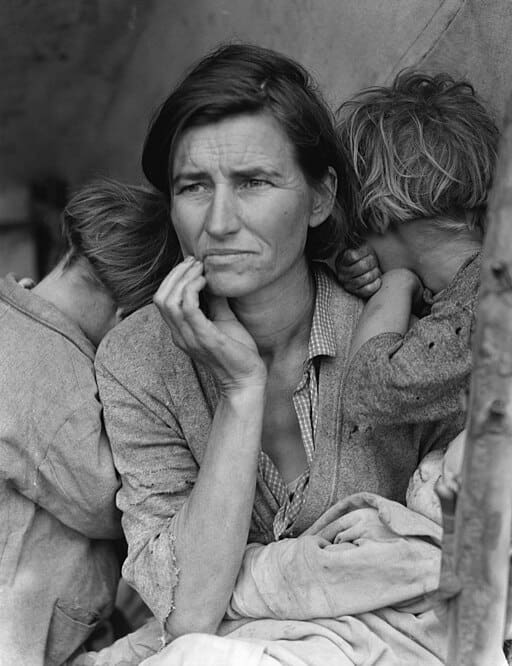
Migrant Mother (1936). Dorothea Lange, Public domain, via Wikimedia Commons
In 1936, Dorothea Lange captured an image that etched the plight of Depression-era America into history. Traveling for the Farm Security Administration, Lange encountered a destitute mother of seven in a California migrant camp. Framed by a tent and blanket, the woman’s furrowed brow and faraway eyes conveyed her worry and weariness. Lange later recounted, “She said that they had been living on frozen vegetables from the surrounding fields and birds that the children killed. She had just sold the tires from her car to buy food.” Published in newspapers nationwide, Migrant Mother humanized the anonymous suffering of Depression victims. Lange’s empathetic portrait ensured this determined mother would symbolize the struggle of women, migrants, and the poor as America battled its greatest economic crisis. The defining image of an era, it still resonates as a testament to the quiet courage required to survive.
2. The Kiss (1945) – Alfred Eisenstaedt’s Photograph of a Sailor Kissing a Nurse in Times Square on V-J Day
On August 14th, 1945, photographer Alfred Eisenstaedt captured an anonymous couple embracing in New York’s Times Square to celebrate the end of World War II. As revelers poured into the streets following news of Japan’s surrender, Eisenstaedt was covering the celebrations for Life magazine when he spotted a sailor suddenly grab and kiss a young nurse. In Eisenstaedt’s words, “He didn’t see the girl he kissed…I was running ahead of him with my Leica looking back over my shoulder… People are covering other people or hanging onto other people. Everyone was kissing.” Published a week later, the image perfectly encapsulated the exhilaration and passion felt nationwide upon the war’s long-awaited conclusion. Now known as V-J Day in Times Square, Eisenstaedt’s photograph remains one of the most iconic celebrations of love, life, and liberation in American history.
3. Afghan Girl (1984) – Steve McCurry’s Penetrating Portrait of a Young Afghan Refugee

Steve McCurry’s. John Ramspott from Oxford, GA, USA, CC BY 2.0, via Wikimedia Commons
In 1984, photojournalist Steve McCurry captured a haunting portrait of a young Afghan refugee with piercing green eyes, its impact stemming from her direct, intense gaze. McCurry encountered the girl at a makeshift school in a Pakistan camp crowded with Afghan refugees who had fled the Soviet invasion of their country. He later remarked on the girl’s striking eyes peeking out from her headscarf, stating “They have this incredible look to them—they’re piercing eyes, but they’re also looking out at you like no one had ever taken her picture before.” Published on the cover of National Geographic in 1985, Afghan Girl drew global attention to the plight of refugees. Nearly two decades later, McCurry astonishingly located the subject, Sharbat Gula, and photographed her again, putting a face to the consequences of war.
4. Lunch Atop a Skyscraper (1932) – The Famous Image of 11 Workers Having Lunch on a Beam 69 Floors Above Manhattan
In 1932, a cluster of construction workers sat nonchalantly eating lunch together 69 floors up on an unfinished skyscraper, as photographs captured their feat for posterity. Shot during construction of 30 Rockefeller Plaza, the black-and-white images show 11 fearless men taking a break on a steel beam precariously perched 850 feet in the air. Photographer Charles C. Ebbets masterfully conveyed the risky scene high above Manhattan as laborers laughed, chatted, and opened fedoras and lunch pails hundreds of feet up with no safety harnesses. Despite its hair-raising setting, the photograph exudes a mood of camaraderie and peace. “Lunch atop a Skyscraper” gave America a glimpse of the daily lives of working men and the casual fearlessness required building the country’s iconic skylines. The quintessential representation of courage and brotherhood, it remains among history’s most unforgettable depictions of man’s relationship with heights.
5. The Burning Monk (1963) – Malcolm Browne’s Shocking Image of a Buddhist Monk’s Self-immolation in Protest

The Burning Monk (1963). See page for author, Public domain, via Wikimedia Commons
On June 11, 1963, the world was confronted with a grisly act of protest against religious oppression when Buddhist monk Thích Quảng Đức calmly sat down in a busy Saigon intersection, soaked himself in gasoline, and lit himself on fire. New York Times photographer Malcolm Browne documented the horrific event, capturing the monk’s composed posture as the flames consumed his body. Đức undertook the sacrificial act to protest the South Vietnamese government’s discrimination against Buddhists. Browne’s jarring photographs relayed this injustice to the world, helping sway US opinion against supporting President Diệm’s regime. Time magazine later declared the images among the century’s most influential, for “burning the movement into the Western mind.” Đức’s sacrificial act remains among history’s most shocking displays of protest, immortalized through Browne’s troubling yet monumental photography.
6. V-J Day in Times Square (1945) – Alfred Eisenstaedt’s Joyous Capture of a Sailor Kissing a Nurse on V-J Day
On August 14, 1945, famed LIFE magazine photographer Alfred Eisenstaedt captured one of history’s most iconic photographs. In Times Square, Eisenstaedt spotted a jubilant sailor who spontaneously grabbed and kissed a young nurse amidst raucous celebrations sparked by news of Japan’s surrender. As euphoric New Yorkers unleashed pent-up elation, this anonymous couple’s fleeting embrace crystallized the nation’s collective exhilaration. Eisenstaedt swiftly focused and shot four frames, freezing a moment that would epitomize victory and newfound peace. Published just days later in LIFE, the image imprinted tender humanity onto public memory of World War II’s long-awaited end. While the kissers’ identities remain mysterious, their unguarded spontaneity embodied the outpouring of emotion felt by all upon the war’s conclusion. Decades later, Eisenstaedt’s photograph persists as an ebullient and eternal reminder of love’s triumph over adversity.
7. Migrant Mother (1936) – Dorothea Lange’s Iconic Portrait of Hardship During the Great Depression
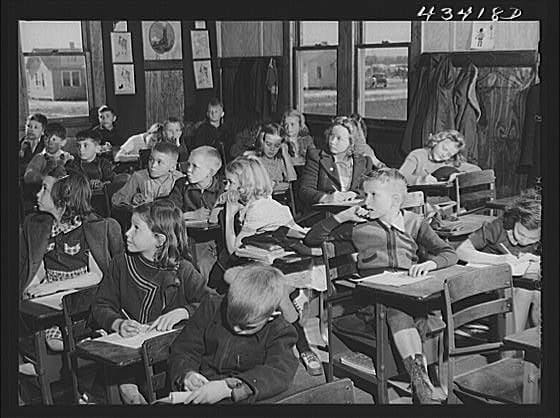
The Great Depression.Farm Security Administration, Public domain, via Wikimedia Commons
In 1936, Dorothea Lange captured an image that etched the plight of Depression-era America into history. Traveling for the Farm Security Administration, Lange encountered a destitute mother of seven in a California migrant camp. Framed by a tent and blanket, the woman’s furrowed brow and faraway eyes conveyed her worry and weariness. Lange later recounted, “She said that they had been living on frozen vegetables from the surrounding fields and birds that the children killed. She had just sold the tires from her car to buy food.” Published in newspapers nationwide, Migrant Mother humanized the anonymous suffering of Depression victims. Lange’s empathetic portrait ensured this determined mother would symbolize the struggle of women, migrants, and the poor as America battled its greatest economic crisis. The defining image of an era, it still resonates as a testament to the quiet courage required to survive.
8. The Hindenburg Disaster (1937) – Sam Shere’s Photograph of the Hindenburg Zeppelin Crashing to the Ground in Flames
On May 6, 1937, the German zeppelin Hindenburg was preparing to dock at Naval Air Station Lakehurst in New Jersey after its transatlantic flight from Germany. As the Hindenburg hovered above the airfield, a fire suddenly broke out on the ship’s tail. Photographer Sam Shere of the International News Photo agency had been assigned to cover the Hindenburg’s arrival and was ready with his camera. As the Hindenburg erupted into flames and began its rapid descent, Shere snapped a series of photos capturing the ship’s destruction. His most famous photo shows the 804-foot zeppelin tilted at a 45-degree angle, fully engulfed in flames just seconds before crashing to the ground. With billowing smoke and spectators running frantically, Shere’s photograph conveyed the panic and tragedy of the disaster that claimed 36 lives. The dramatic image became one of the most iconic photographs of the 20th century.
9. The Falling Man (2001) – Richard Drew’s Controversial 9/11 Photograph of a Man Falling from the Towers
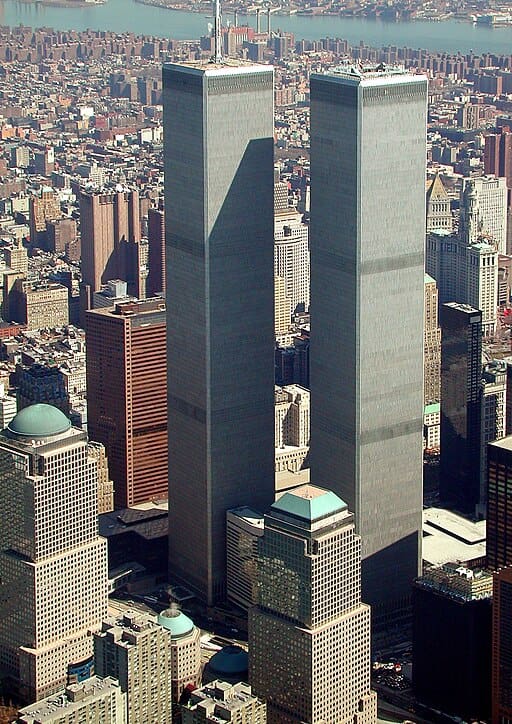
World Trade Center. Jeffmock, Public domain, via Wikimedia Commons
On the morning of September 11, 2001, Associated Press photographer Richard Drew was covering the terrorist attacks on the World Trade Center in New York City. After the South Tower was struck by a plane and collapsed, Drew turned his camera to the North Tower just as a man trapped above the fire and destruction fell from an upper floor. At 9:41 AM, Drew snapped a chilling photograph of the man plunging headfirst in a vertical position, with smoke billowing in the background. Published in newspapers the next day, Drew’s photo became one of the most recognizable yet controversial images from 9/11 due to the disturbing way it captured one man’s unthinkable fate. The unknown Falling Man was believed to be an office worker, and the photo’s provocative depiction of his powerless freefall was both unforgettable and traumatic for many Americans grappling with the horrors of that day.
10. Tank Man (1989) – Jeff Widener’s Picture of a Lone Figure Blocking Chinese Tanks at Tiananmen Square
During the Tiananmen Square protests in June 1989, Associated Press photographer Jeff Widener captured one of the most enduring images of the 20th century. On June 5th, a day after the Chinese military violently cleared Tiananmen Square, Widener was perched in a hotel balcony six blocks away, documenting the aftermath. As a convoy of tanks exited the square, a lone man carrying shopping bags stepped into the road and blocked their path. The unidentified “Tank Man” stood defiantly before the lead tank, even as it tried maneuvering around him. Widener snapped a series of photos of the tense standoff before the man was whisked away by onlookers. Published worldwide, Widener’s photograph became a powerful symbol of human resistance, thrusting the Tank Man into the international spotlight as an icon of the struggle for human rights and democracy in China. The Tiananmen Square massacre ended that movement, making the Tank Man’s solitary act all the more striking.
11. The Power of One (1968) – Tommie Smith and John Carlos Giving the Black Power Salute at the 1968 Olympics

The Power of One (1968) – Tommie Smith and John Carlos.Angelo Cozzi (Mondadori Publishers), Public domain, via Wikimedia Commons
During the 1968 Olympics in Mexico City, American sprinters Tommie Smith and John Carlos were set to receive gold and bronze medals for the 200-meter race. But on the podium, the two Black athletes stunned the world when they bowed their heads and raised black-gloved fists during the US national anthem in protest of racism and oppression. As the Star-Spangled Banner played in the stadium, Smith and Carlos’ silent gesture spoke volumes, becoming an iconic symbol of Black Power and the larger civil rights movement sweeping America. With a global audience tuned into the Olympics, the brave, defiant protest by Smith and Carlos on October 16, 1968 drew international attention to racial inequality, human rights, and the plight of African Americans. Though the runners were condemned and excluded from the games, their singular act of resistance was immortalized in photographs and remains one of the most indelible images of standing up against injustice.
12. The Burning Monk (1963) – Malcolm Browne’s Pulitzer Prize-Winning Photograph of Thích Quảng Đức’s Self-immolation
On June 11, 1963, Vietnamese Mahayana Buddhist monk Thích Quảng Đức staged a dramatic protest against the persecution of Buddhists under President Ngo Dinh Diem’s regime. Sitting calmly in the lotus position on a busy Saigon Street, Thích Quảng Đức was doused in gasoline by fellow monks and set himself ablaze. As flames engulfed his body, he remained motionless and silent in profound meditation. Associated Press reporter Malcolm Browne captured the horrific act in a series of shocking photos that were published worldwide. Browne’s images conveyed the enormity of this sacrifice, drawing global outrage against the repressive Vietnamese government. The Burning Monk photo became an iconic and galvanizing symbol of resistance, contributing to Diem’s eventual overthrow. Browne’s Pulitzer Prize-winning photograph remains one of the most stunning examples of the extremes to which humans will go to protest profound injustice.
13. Einstein’s Stick Out Tongue (1951) – Arthur Sasse’s Humorous image of Einstein Being Playful

Albert Einstein. Photograph by Orren Jack Turner, Princeton, N.J. Modified with Photoshop by PM_Poon and later by Dantadd., Public domain, via Wikimedia Commons
On March 14, 1951, Albert Einstein was celebrating his 72nd birthday at Princeton University. Photographer Arthur Sasse was trying to persuade the typically serious scientist to smile for a quick portrait. But Einstein was exhausted from the festivities and refused to cooperate. At the precise moment Sasse snapped his photo, Einstein reacted playfully by sticking out his tongue instead. In the humorous picture, Einstein’s wild hair is frizzed in all directions as he appears almost impish, capturing a rare silly moment from the distinguished Nobel laureate. Initially considered a flubbed shot, Sasse’s photo revealed a whimsical side of Einstein few had seen before. Published in 1952 in Life magazine among other amusing Einstein images, the iconic photo became one of the most memorable pictures ever taken of the famous physicist. Thanks to Arthur Sasse’s perfect timing, Einstein’s famous tongue snapshot has endured as the pinnacle of playful pop culture brilliance.
14. Che Guevara (1960) – Alberto Korda’s Iconic Portrait of Marxist Revolutionary Che Guevara
In 1960, Cuban photographer Alberto Korda captured one of the most iconic images of the 20th century. On March 5th, Korda was covering a memorial service in Havana for victims of an exploded ship. Ernesto “Che” Guevara, a key leader of the Cuban Revolution, was among the speakers. As Guevara stepped onto the stage, Korda was transfixed by his imposing, resolute expression. With a rapid shot, Korda immortalized this fleeting moment in a single frame that embodied Che’s characteristic defiance, stoicism, and fiery conviction. Though not widely published at first, Korda’s portrait gained renown years later as Che’s legend grew, transforming him into the ubiquitous symbol of rebellion and socialism. Thanks to its bold graphic style perfectly encapsulating Che’s anti-establishment ethos, Korda’s Guerrillero Heroico became one of the most reproduced photos ever—an enduring emblem of revolution and social justice for generations worldwide.
15. Dali Atomicus (1948) – Philippe Halsman’s Surreal Photograph of Salvador Dalí Jumping with Cats and Water Buckets

Dali Atomicus (1948). Philippe Halsman, Public domain, via Wikimedia Commons
In 1948, photographer Philippe Halsman collaborated with Salvador Dalí on a uniquely surreal portrait titled Dali Atomicus. Halsman sought to capture Dalí “in suspension, as if floating.” To achieve this, assistants hurled three cats and buckets of water into the frame while Dalí jumped off a stool amid the chaos, with chair and easel suspended overhead by wires. The absurd scene required over two dozen takes as cats flew wildly and drenched everyone involved. Halsman finally got the perfect shot of Dalí floating gracefully, everyday objects scattered whimsically around him. The making of Atomicus mirrored the zany antics of Dalí himself. When published in Life magazine, the bizarre photograph delighted Dalí and Halsman, perfectly encapsulating the avant-garde spirit of Surrealism. Dali Atomicus became an iconic encapsulation of Dalí’s explosive genius and showmanship, memorializing his lust for theatrics and disregard for physics through Halsman’s delightfully absurd photograph.
16. The Situation Room (2011) – Pete Souza’s Photograph of White House Staff Anxiously Monitoring the Osama bin Laden Raid
On May 1, 2011, White House photographer Pete Souza captured one of the most memorable images of the Obama presidency – the Situation Room. As U.S. Navy Seals raided Osama bin Laden’s compound in Abbottabad, Pakistan, President Obama and his national security team anxiously monitored the covert operation in real time. Souza’s photograph shows Obama, Vice President Biden, and senior advisors staring intently at a screen displaying the raid. The tense scene encapsulates the immense risks and stakes involved in targeting America’s most wanted terrorist mastermind. As Secretary of State Clinton covers her mouth in dismay, the photo dramatically reflects the extreme tension and suspense inside the room. When published the next day after Bin Laden was confirmed eliminated, Souza’s Pulitzer Prize-winning photo became an iconic record of this pivotal moment in the War on Terror. The Situation Room offers a rare glimpse into the complexities of presidential decision-making and the nerve-wracking risks involved in special ops missions.
17. Bliss (1995) – Charles O’Rear’s Default Windows XP Landscape of Rolling Green Hills
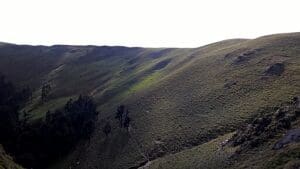
Windows XP Landscape. RitabaN GuhA, CC BY-SA 4.0, via Wikimedia Commons
In January 1995, American photographer Charles O’Rear was driving through the wine country of Napa Valley, California when he spotted a vibrant, emerald-green hill set against a bright blue sky. O’Rear quickly pulled over and snapped a picture of the scenic vista with his medium-format camera. This photograph, titled “Bliss,” captured a serene landscape of vineyards and rolling hills bathed in golden sunlight. In 1996, Microsoft licensed the image from O’Rear for use as the default desktop background for Windows XP, launched in 2001. As over 1 billion users gazed at Bliss daily, it became one of the most viewed photos in history. While O’Rear only received a modest one-time payment from Microsoft, Bliss’s widespread exposure cemented its icon status. Nearly three decades later, O’Rear’s untouched image of divine scenery in California wine country remains globally recognized for its idyllic and soothing vision of natural beauty.
18. Earthrise (1968) – Astronaut William Anders’ Pivotal View of Earth from Lunar Orbit
On December 24, 1968, Apollo 8 astronauts Frank Borman, James Lovell, and William Anders became the first humans to orbit the Moon. While making their fourth pass around the far side of the Moon, the crew witnessed a sight no human had ever seen before – the striking view of Earth rising above the lunar horizon. Scrambling for his camera, Anders photographed the breathtaking Earthrise as the blue and white “marble” of Earth ascended from behind the Moon’s gray surface. The awe-inspiring photo offered a humbling new perspective on Earth’s fragile beauty suspended in the vast darkness of space. As Anders’ photo spread across the world’s front pages, this iconic image marked a pivotal turning point in humanity’s view of our planet and our place in the universe. Earthrise would help galvanize the budding environmental movement and reinforce the urgent need to protect the only planet that humans have ever called home.
19. The Steerage (1907) – Alfred Stieglitz’s Image of Immigrants Leaving the Lower Decks of a Steamship

The Steerage (1907). Alfred Stieglitz, CC0, via Wikimedia Commons
In 1907, photographer Alfred Stieglitz was traveling to Europe when he captured an iconic image of immigrant families leaving the lower decks of a steamship. Stieglitz titled it The Steerage, referring to the cheap enclosed section where working-class passengers rode. As passengers emerge from shadows into sunlight, the photo’s striking composition contrasts the steerage’s dim confinement against the ship’s gleaming upper decks. Stieglitz later remarked that the image represented “the beginning of a new life in a new world.” When the Steerage was first exhibited in 1911, its empathetic portrayal of immigrants was highly praised. Stieglitz demonstrated that photography could capture human emotion and social issues just as meaningfully as painting. The photo has endured as his signature work, exemplifying early documentary photography. As an unflinching yet poignant depiction of the American immigrant experience, The Steerage remains a landmark in the development of photojournalism and socially conscious photography in America.
20. Napoleon at Saint-Bernard Pass (1801) – Jacques-Louis David’s Dramatic Painting of Napoleon Braving the Alps
In May 1800, Jacques-Louis David accompanied French General Napoleon Bonaparte on his famous crossing of the Great St. Bernard Pass through the Alps to invade Italy. David witnessed the heroic scene as Napoleon led his army atop a fiery steed across the snowy, treacherous mountains. In 1801, David immortalized the epic journey in his dramatic painting Napoleon at Saint-Bernard Pass. Amid the frigid, rugged landscape, Napoleon embodies courage and determination, his cloak billowing behind him and arm outstretched in a gesture of leadership. David captures Napoleon at the peak of power and conquest, propagating his near mythic status as a military genius. The iconic image became a powerfully enduring symbol of Napoleon’s ambition and charisma. Through his skillful propaganda portrait conveying nobility and valor, David helped elevate Napoleon as an idol of French national identity at the height of his supremacy. The crossing of the Alps marked a decisive moment in Napoleon’s storied career, dynamically envisioned in David’s masterpiece.
21. The Terror of War (1964) – Nick Ut’s Pulitzer Prize-Winning Photo of a Young Vietnamese girl Fleeing a Napalm Attack

Nick Ut’s Pulitzer. David Hume Kennerly, Public domain, via Wikimedia Commons
On June 8, 1972, Associated Press photographer Nick Ut captured one of the most harrowing images of the Vietnam War. While photographing an attack on the village of Trang Bang, Ut encountered screaming children running from a misdirected napalm bombing. Among them was a badly burned 9-year-old girl, Phan Thi Kim Phuc. As South Vietnamese planes accidentally dropped napalm on civilians, Ut photographed Kim Phuc tearing off her burning clothes while she fled in agony. Capturing the full horror of the accidental attack on innocents, Ut’s Pulitzer Prize-winning photo became a chilling and unforgettable indictment of war’s indiscriminate brutality. Nick Ut rushed Kim Phuc and other children to get medical care after photographing their ordeal. The photo’s horrific imagery fueled the growing anti-war movement in America, profoundly shaping public perceptions of the conflict. The Terror of War remains an iconic reminder of war’s devastating toll on civilians and the journalistic power of photography.
22. Nighthawks (1942) – Edward Hopper’s Painting of Customers at a Brightly Lit Diner Late at Night
Painted in 1942 at the height of World War II, Edward Hopper’s Nighthawks depicts four customers quietly seated at a brightly lit downtown diner late at night. Hopper based the all-night diner on an actual restaurant in Greenwich Village, using the artificial lighting of the empty eatery to create an environment both familiar yet strangely unsettling. The painting portrays an anonymous scene of urban isolation and anonymity. The four customers appear lost in thought, seemingly detached or indifferent to one another’s company as they pass time in the late hour. With its stark contrast of light and shadow heightened by a moody use of color, Nighthawks evokes the quiet solitude of American life in the 1940s. By lending universal appeal to the ordinary experience of passing time in impersonal yet public spaces, Hopper perfectly captured the late-night introspection and emotional disconnect of modern urbanity through his magnum opus. Nighthawks remains Hopper’s most renowned work and one of the great emblems of American art.
23. Abbey Road (1969) – Iain Macmillan’s Album Cover Photo of The Beatles Striding Across a London Crosswalk
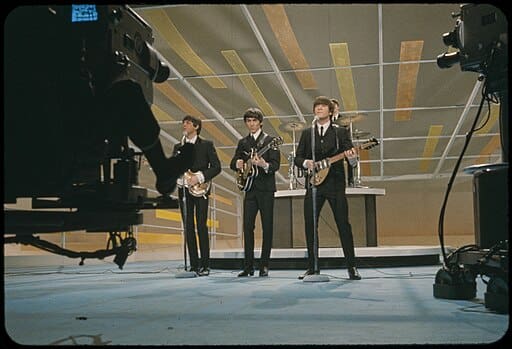
The Beatles.Library of Congress, Public domain, via Wikimedia Commons
In August 1969, Scottish photographer Iain Macmillan was given only 10 minutes to photograph The Beatles walking across the street outside Abbey Road Studios in London for their upcoming album cover. On the morning of August 8th, Macmillan positioned a stepladder in the middle of Abbey Road while a policeman held up traffic. Macmillan quickly took six photos as The Beatles walked back and forth across the famous crosswalk. In the end, the fifth photo was chosen – the only one where all four Beatles stepped in unison. This iconic image shows John Lennon leading the group, followed by Ringo Starr, Paul McCartney barefoot, and George Harrison. The spontaneous photo shoot resulted in one of the most famous and imitated albums covers in history. Macmillan’s photo, mimicking a literal crossing for the world’s biggest band, represents the last time all four Beatles were photographed together at the legendary Abbey Road Studios where they recorded their groundbreaking music.
24. The Soiling of Old Glory (1976) – Stanley Forman’s Impactful Photograph of a White Teenager Spearing a Black Man with an American Flag.
On April 5th, 1976, Boston Herald American photographer Stanley Forman captured a racial attack during protests over school busing. As African American Ted Landsmark walked on City Hall Plaza, he was assaulted with a pole flying the American flag by Joseph Rakes, a white teenager opposed to integration. Forman’s framed the image just as the flag’s tip struck Landsmark’s face. By photographing this act of racial violence with the flag as the weapon, Forman created an image that conveyed the ironic hypocrisy of the attack. Published nationwide, the shocking photo became a Pulitzer Prize-winning indictment of racism in Boston during the busing desegregation movement. Called The Soiling of Old Glory, Forman’s photo powerfully unveiled the ugly persistence of prejudice by symbolically besmirching the values represented by America’s flag. Its damning imagery resonated across the country, delivering an unfiltered look at the nation’s ongoing struggle against intolerance.
25. Guernica (1937) – Pablo Picasso’s Monumental Anti-War Painting Depicting the Bombing of Guernica, Spain
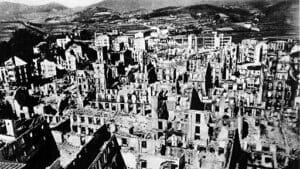
Guernica (1937). AnonymousUnknown author (CDBG), Public domain, via Wikimedia Commons
In 1937, Pablo Picasso was commissioned by the Spanish Republican government to create a large mural for the Spanish pavilion at the Paris World’s Fair. On April 26, 1937, Nazi Germany bombed the small Basque town of Guernica in support of the Nationalist forces during the Spanish Civil War. Shocked by the horrific civilian attack, Picasso channeled his outrage into a 6.5 x 11-meter painting titled Guernica. The monumental canvas dramatizes the bombing with distorted, anguished figures like wounded animals, a crying mother, and dismembered corpses. Painted in stark black, white, and gray, Guernica conveys the senseless violence and suffering inflicted through the inhumanity of war. Picasso created an enduring anti-war symbol, exposing the tragedies of Fascist aggression while garnering sympathy for the Republicans’ cause. Guernica still stands as one of history’s most powerful war paintings, its unforgettable imagery forever etched in the global consciousness as an anti-war tour de force.
26. The Tetons and the Snake River (1942) – Ansel Adams’ Breathtaking Black-and-White Photograph of the Grand Teton Mountain Range
In 1942, Ansel Adams captured one of his most iconic images, The Tetons and the Snake River. While photographing in Grand Teton National Park, Adams positioned his camera to frame the jagged Teton range reflecting perfectly in the Snake River below. Using his signature zone system technique, Adams precisely exposed the shot for two hours to achieve optimal contrast in the black and white print. The final image portrays the awe-inspiring grandeur of the Wyoming mountains and sublime interplay of light, land, and water. Adams called The Tetons and the Snake River his “best-known photograph” and the embodiment of his environmental ethos. Through dramatic contrast and textures, the photo encapsulates the majesty of the American West that Adams aimed to preserve through his art. The timeless image later helped expand protection for the Tetons as controversy over a dam threatened the unspoiled landscape. Ansel Adams’ masterful vision cemented The Tetons and the Snake River as one of the most iconic photographs of the natural world.
27. Identical Twins (1967) – Diane Arbus’ Mesmerizing Portrait of Creepy Identical Twin Sisters
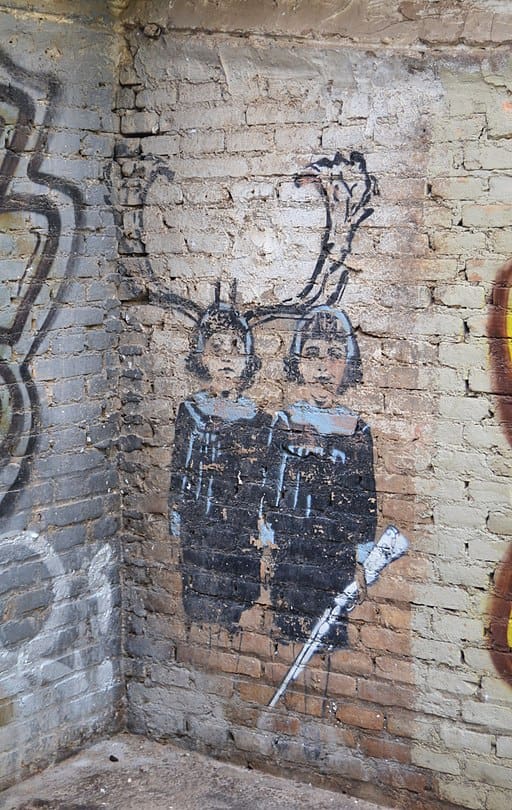
Grafiti of Portrait of Creepy Identical Twin Sisters.Joanbanjo, CC BY-SA 4.0, via Wikimedia Commons
In 1967, photographer Diane Arbus captured one of her most unsettling images – Identical Twins, portraying two mysterious seven-year-old sisters. Arbus met the twins at a New Jersey school and was compelled to photograph them staring hauntingly with matching dresses and hairstyles. Their strange, penetrating gazes give them an otherworldly quality. The twins’ closely cropped faces and luminous black backgrounds enhance the hypnotic effect, lending the photo psychological undertones of identity and the uncanny. Published in The New York Times after Arbus’ death in 1971, Identical Twins quickly became an indelible emblem of Arbus’ voyeuristic fascination with societal outsiders. The eerie portrait exemplified her signature style of revealing shared human frailties through probing, often disturbing portraits. To this day, the twins’ bizarre mystique draws endless interpretation, leaving Identical Twins one of the most unforgettable and ambiguous images of the 20th century.
28. The Great Wave off Kanagawa (1830-1833) – Katsushika Hokusai’s Iconic Japanese Woodblock Print of a Massive Wave
The Great Wave off Kanagawa is one of Japanese artist Katsushika Hokusai’s most iconic works. Created around 1830 as part of his Thirty-six Views of Mount Fuji series, it depicts a giant wave threatening three boats off the coast of Kanagawa Prefecture. Executed in the ukiyo-e woodblock print style, Hokusai’s dramatic blue wave contrasts with the distant view of Mt. Fuji and underscores the power and danger of the sea. The cresting wave and its claw-like fingers seem to engulf the helpless boats, giving human pursuits a sense of smallness and futility against nature’s magnitude. The Great Wave has become globally recognized as an emblem of Japanese art and a powerful, dynamic image of the sublime in nature. Its fame attests to Hokusai’s mastery of composition, line, and color.
29. Guerrillero Heroico (1960) – Alberto Korda’s Romanticized Portrait of Che Guevera That Became a Global Symbol of Revolution
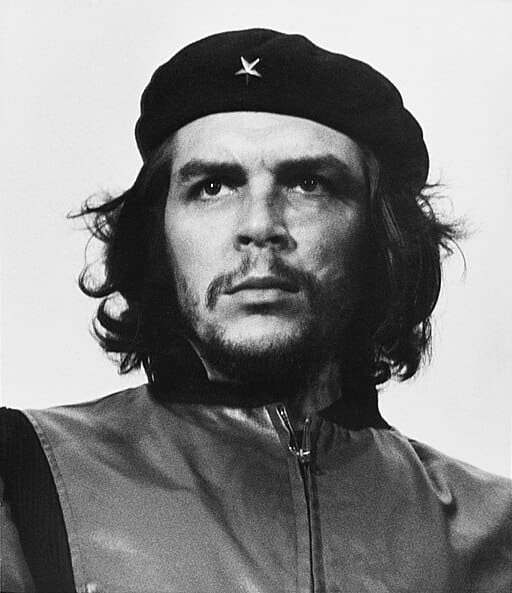
Guerrillero Heroico (1960).Alberto Korda, restored by Adam Cuerden, Public domain, via Wikimedia Commons
Alberto Korda’s iconic 1960 photograph Guerrillero Heroico immortalized Che Guevara as a romantic revolutionary icon. Taken at a memorial service in Havana, the portrait captured Guevara’s stoic, Christ-like gaze emerging from the darkness. With his eyes fixed in a visionary stare toward a revolutionary future, Guevara became the epitome of rebellion and hope. Korda’s close-up crop of the original image further mythologized El Che by focusing tightly on his handsome, brooding face and mane of hair. As reproduced on t-shirts, posters, and protest banners worldwide, Guerrillero Heroico evolved into a ubiquitous emblem of revolt against oppression. Korda’s simple but powerful photograph bridged cultures to make El Che’s image synonymous with change and a continuing struggle for social justice.
30. Horse in Motion (1878) by Eadweard Muybridge
Eadweard Muybridge’s 1878 Horse in Motion photography series revolutionized the way motion is captured on film. To settle a debate about whether all four of a horse’s hooves leave the ground during a gallop, Muybridge arranged a series of cameras along a racetrack triggered by trip wires. The resulting series of rapid-fire images clearly showed the horse fully airborne during certain phases of its gallop, with no hooves touching the ground. Muybridge’s repetitive images tracing the horse’s movement gave vision to something imperceptible to the human eye. The series marked a breakthrough in recording motion photographically, laying the groundwork for innovations like motion pictures. Muybridge’s groundbreaking step-by-step visual narrative of animal locomotion changed perceptions about movement and the capabilities of the camera.
Let these 30 iconic photographs be your time machine, transporting you to pivotal moments in history and etching unforgettable stories onto your soul. Remember, the past is never truly gone; it lives on in every perfectly captured frame, waiting to whisper its secrets to those who dare to listen.
Planning a trip to Paris ? Get ready !
These are Amazon’s best-selling travel products that you may need for coming to Paris.
Bookstore
- The best travel book : Rick Steves – Paris 2023 – Learn more here
- Fodor’s Paris 2024 – Learn more here
Travel Gear
- Venture Pal Lightweight Backpack – Learn more here
- Samsonite Winfield 2 28″ Luggage – Learn more here
- Swig Savvy’s Stainless Steel Insulated Water Bottle – Learn more here
Check Amazon’s best-seller list for the most popular travel accessories. We sometimes read this list just to find out what new travel products people are buying.









